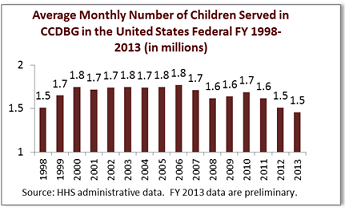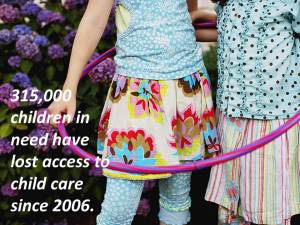
The Number of Children Benefiting from Federal Low-Income Child Care Program at a 15 Year Low
Please check out this troubling piece about child care by the Coalition on Human Needs' Lecia Imbery. For more like this, please subscribe to Voices for Human Needs, at http://www.chn.org/blog/
By Lecia Imbery
The number of children receiving child care funded by the Child Care and Development Block Grant (CCDBG) fell to a 15-year low, according to CLASPanalysis of data from the Department of Health and Human Services. The CCDBG is the primary source of federal funding for helping low-income families pay for child care, with half of the families who receive benefits living below the poverty level.
In 2013, 1.46 million children received child care funded through the CCDBG in an average month, roughly 47,500 fewer children than in 2012 and 315,000 fewer than in 2006. Somestates have an even bigger percentage drop, with Maine serving 72 percent fewer children in 2013 than they did in 2006 and DC down 54 percent over that time period.
In addition to this decline in the number of children served, CLASP notes that state and federal spending on child care – which includes funds from CCDBG and the Temporary Assistance for Needy Families (TANF) block grant – is at a 10-year low. As Carol Burnett of the Mississippi Low Income Child Care Initiative noted in last week’s blog post about child care centers serving low-income families, only 1 out of every 6 children eligible for assistance actually got any help due to lack of funding, even before this latest drop.
 Ensuring that low-income families have access to quality, affordable child care is critical. Parents need child care so they can go to work or participate in education and training programs to get a better job. And children need quality care that fosters early learning in a safe environment. The subsidies they receive allows families to use their limited resources on their many other expenses, like food and rent. Without the help of CCDBG funds, children – and the entire family stability – could be at risk.
Ensuring that low-income families have access to quality, affordable child care is critical. Parents need child care so they can go to work or participate in education and training programs to get a better job. And children need quality care that fosters early learning in a safe environment. The subsidies they receive allows families to use their limited resources on their many other expenses, like food and rent. Without the help of CCDBG funds, children – and the entire family stability – could be at risk.
The National Women’s Law Center also has a new report on state child care assistance policies, including funding for programs, income eligibility limits for parents, length of waiting lists, and eligibility for families with parents looking for a job. On the “good news” side, it shows that families in two-thirds of the states were better off in February 2014 than they were a year prior under one or more of the child care assistance policies covered in the report. But families in more than a quarter of the states were worse off, and the Law Center’s findings also show there are still far too many children whose families aren’t receiving the help they need. Too many states have long waiting lists for assistance, income eligibility rules that shut out low-income parents, and low child care reimbursement rates that make quality, accessible child care too hard to come by.
A bill that would reauthorize the CCDBG for the first time since 1996 and increase the authorized level of funding for the program passed the House in September, but it’s being held up in the Senate. Reports like these from CLASP and the National Women’s Law Center should be used to show Senators just how important it is to act quickly. Millions of low-income children and their families are waiting for help.



The views and opinions expressed in this post are those of the author(s) and do not necessarily reflect those of MomsRising.org.
MomsRising.org strongly encourages our readers to post comments in response to blog posts. We value diversity of opinions and perspectives. Our goals for this space are to be educational, thought-provoking, and respectful. So we actively moderate comments and we reserve the right to edit or remove comments that undermine these goals. Thanks!